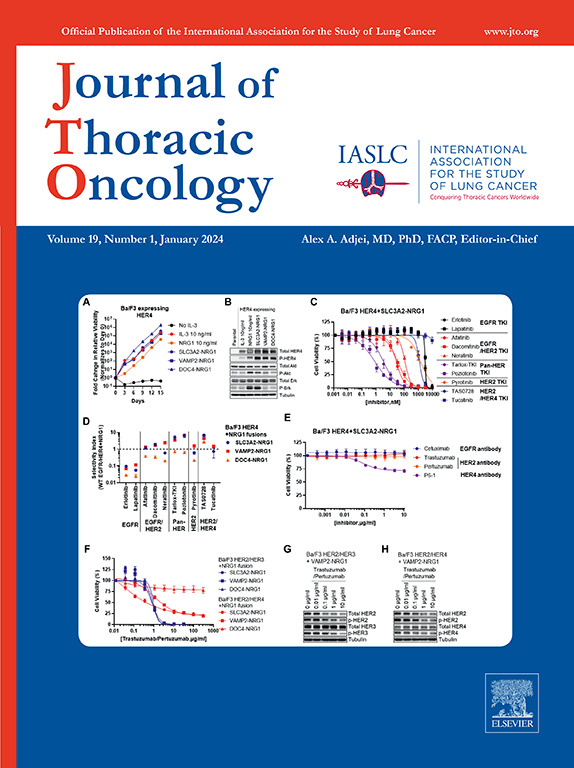治疗复发小细胞肺癌(SCLC)的 Lurbinectedin 加 pembrolizumab:I/II 期 LUPER 研究。
IF 20.8
1区 医学
Q1 ONCOLOGY
引用次数: 0
摘要
小细胞肺癌(SCLC)化疗后的二线治疗选择有限。我们评估了lurbinectedin联合派姆单抗治疗未接受过免疫治疗的复发性SCLC患者的有效性和安全性,旨在防止早期进展并实现持续反应。方法:LUPER试验(NCT04358237)是一项I/II期、单臂、开放标签、多中心研究。第一阶段确定了推荐的第二阶段剂量(RP2D)。II期的主要终点是研究者确认的客观缓解率(ORR)。次要终点包括反应持续时间(DoR)、无进展生存期(PFS)、总生存期(OS)和安全性。患者分为铂敏感(无化疗间隔≥90天)或铂耐药(结果:RP2D为3.2 mg/m2鲁比奈汀和200 mg派姆单抗IV每3周)。II期纳入28例患者,50%为铂耐药。ORR为46.4% (95% CI, 27.5-66.1;结论:Lurbinectedin联合派姆单抗在复发性SCLC中显示出有希望的疗效,特别是对于铂敏感患者,具有已知和可管理的安全性。这些结果支持进一步探索这种联合治疗SCLC。本文章由计算机程序翻译,如有差异,请以英文原文为准。

Lurbinectedin Plus Pembrolizumab in Relapsed SCLC: The Phase I/II LUPER Study
Introduction
SCLC has limited second-line treatment options after chemotherapy. We assessed the efficacy and safety of lurbinectedin combined with pembrolizumab in relapsed SCLC patients who had not received prior immunotherapy, aiming to prevent early progression and achieve sustained responses.
Methods
The LUPER trial (NCT04358237) is a phase I/II, single-arm, open-label, multicenter study. Phase I established the recommended phase II dose. The primary endpoint of phase II was the investigator-confirmed objective response rate. Secondary endpoints included duration of response, progression-free survival (PFS), overall survival (OS), and safety. Patients were categorized as platinum-sensitive (chemotherapy-free interval ≥ 90 d) or platinum-resistant (<90 d).
Results
The recommended phase II dose was 3.2 mg/m2 lurbinectedin and 200 mg pembrolizumab IV every three weeks. Phase II included 28 patients, 50% of whom were platinum-resistant. The objective response rate was 46.4% (95% confidence interval: 27.5–66.1, p < 0.001), including three complete responses, with two complete metabolic responses post-treatment completion at 35 cycles. The median duration of response was 7.8 months, with 40% of patients maintaining responses for 12 months or longer. The median PFS was 4.6 months, and the median OS was 10.5 months. Platinum-sensitive patients had significantly better PFS (8.0 versus 2.8 mo, p = 0.012) and numerically superior OS (15.7 versus 7.1 mo, p = 0.058). Grade 3 or higher treatment-related adverse events occurred in 71.4% of patients, with transient neutropenia being the most common. Immune-related adverse events were consistent with prior pembrolizumab studies.
Conclusions
Lurbinectedin plus pembrolizumab reported promising efficacy in relapsed SCLC, particularly for platinum-sensitive patients, with a known and manageable safety profile. These results support further exploration of this combination in SCLC treatment.
求助全文
通过发布文献求助,成功后即可免费获取论文全文。
去求助
来源期刊

Journal of Thoracic Oncology
医学-呼吸系统
CiteScore
36.00
自引率
3.90%
发文量
1406
审稿时长
13 days
期刊介绍:
Journal of Thoracic Oncology (JTO), the official journal of the International Association for the Study of Lung Cancer,is the primary educational and informational publication for topics relevant to the prevention, detection, diagnosis, and treatment of all thoracic malignancies.The readship includes epidemiologists, medical oncologists, radiation oncologists, thoracic surgeons, pulmonologists, radiologists, pathologists, nuclear medicine physicians, and research scientists with a special interest in thoracic oncology.
 求助内容:
求助内容: 应助结果提醒方式:
应助结果提醒方式:


